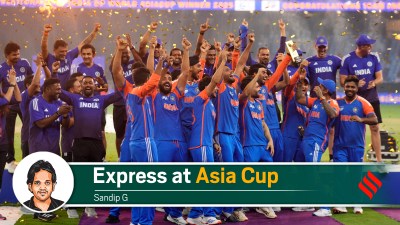Stay updated with the latest - Click here to follow us on Instagram
Chhota Rajan arrested: From Dawood Ibrahim’s No. 2 to his rival
After Dawood fled for Dubai in 1986, Rajan assumed charge of the D-gang’s operations in India. He joined his boss a year later in Dubai, and helped handle the D-gang’s vast empire.
 The passport recovered from Chhota Rajan.
The passport recovered from Chhota Rajan.
For someone against whom the might of Mumbai Police was engaged for decades, gangster Chhota Rajan’s arrest was almost anti-climactic. After landing at Bali airport from Sydney on Sunday, he gave himself up “without resistance” to a single police officer sent by the local police.
Rajendra Sadashiv Nikalje alias Chhota Rajan’s rise to the helm of a trans-national crime syndicate had a humble beginning in a two-storey chawl in Tilak Nagar, Mumbai. His father worked at a pharmaceutical company, while his mother was a housewife. Rajan had five siblings, three brothers and two sisters. The family had its roots in Lonar village, Satara.
Watch Video:All You Need To Know About Chhota Rajan
Having dropped out of a municipal school in Class V, Rajan’s foray into crime was as a black marketeer of movie tickets outside Sahakar Cinema in Chembur in the mid-70s. Rajan, who went by ‘Nana’ at the time, worked for a local criminal, Jagdish Sharma.
When he assaulted a police constable during a crackdown, he caught the eye of gangster Rajan Nair alias Bada Rajan, who took him under his wing. Nair’s gang was involved in collecting protection money from businessmen in the eastern suburbs of Mumbai. On September 21, 1983, Nair was shot dead in a hit, carried out on orders of his rival Abdul Kunju.
Following this, Rajan took control of the gang and earned the moniker Chhota Rajan. One of the first people he killed was Philip Pandhre, his rival who used to sell tickets in black outside Odeon cinema at Ghatkopar.
Watch Video: The Inside Story Of Chhota Rajan’s Arrest And What Next?
He fired at Kunju when the latter had surrendered to police and was being taken from court to jail, but Kunju survived. He also unsuccessfully tried to kill Kunju in J J Hospital. It was Rajan’s relentless pursuit of Kunju that brought him to the notice of Dawood Ibrahim, who gave him a chance to enter the big league. Rajan joined the D-gang, following which he managed to kill Kunju in the middle of a match in Ghatkopar.
Police officers remember this murder as an example of Rajan’s style of execution. “Rajan recruited a shooter named Sanjay Raggad, who was in dire need of money. Rajan did not have enough money to pay a hefty supari but still convinced Raggad to do the job,” recalled a retired officer. “Rajan would buy food for Raggad to ensure he ate well at least twice a day and show support and sympathy… After an extensive recce, Raggad went up to Kunju, and pumped bullets into him,” he said.
Rajan quickly rose to become Dawood’s “right-hand man”. “He commanded the strongest and largest network of foot-soldiers amongst Dawood’s lieutenants,” said a senior police officer.
After Dawood fled for Dubai in 1986, Rajan assumed charge of the D-gang’s operations in India. He joined his boss a year later in Dubai, and helped handle the D-gang’s vast empire.
In the early ‘90s, Rajan started getting increasingly insecure as people within the gang were jealous of his standing within the inner circle.
When the 1993 serial bomb blasts hit Mumbai, Rajan was reportedly caught unawares. According to several sources, he had no idea that Dawood had hatched such a big plot. Two meanings were read in this — either Dawood did not trust him, or he knew that Rajan would not approve. That’s when Rajan fell out with his boss and the two parted ways acrimoniously. Keen to portray himself as a “patriotic don”, Rajan murdered many key accused in the Mumbai blasts case.
On September 15, 2000, a team of sharpshooters sent by Dawood and led by his lieutenant, Shakeel Babumiyan Sheikh alias Chhota Shakeel, stormed Rajan’s residence in Bangkok’s Sukhumvit area. Rajan managed to escape with a bullet wound to his abdomen by jumping out of a first-floor window. He later managed to escape from a hospital where he was put under watch by the Thailand Police.
Over the years, Rajan has often been perceived to be close to Indian intelligence agencies keen to use his network against Dawood. In July 2005, a team of Mumbai Police officers flew to Delhi and arrested Rajan’s right-hand man Vicky Malhotra, who was travelling in a car with Ajit Kumar Doval, the then director of the Intelligence Bureau and the current National Security Advisor.
Sources say the arrest led to friction between the IB and the Mumbai Police since Malhotra was apparently being used as an asset by the IB. This sparked speculation that intelligence agencies were planning to use Malhotra for an operation against Dawood at the Dubai reception for his daughter’s wedding with Javed Miandad’s son. Eventually, Dawood skipped the reception.
The episode also finds mention in a confidential US diplomatic cable released by WikiLeaks.
In June 1998 in Kathmandu, his aides gunned down Nepali parliamentarian Mirza Dilshad Beg, who was allegedly handling Dawood’s operations and running guns into India with ISI help. In media interviews, Rajan claimed Beg was killed as the ISI was using him for terrorism in India, and that Indian intelligence agencies were aware of the plot to kill Beg.
Suffering from a serious kidney ailment and requiring dialysis regularly, Rajan managed to control a flourishing criminal network despite the splintering of his gang into factions led by formal lieutenants.
The brazen murder of journalist J Dey in Mumbai in June 2011 by his aides served as a reminder that Rajan continued to command a network capable of daring underworld operations.







